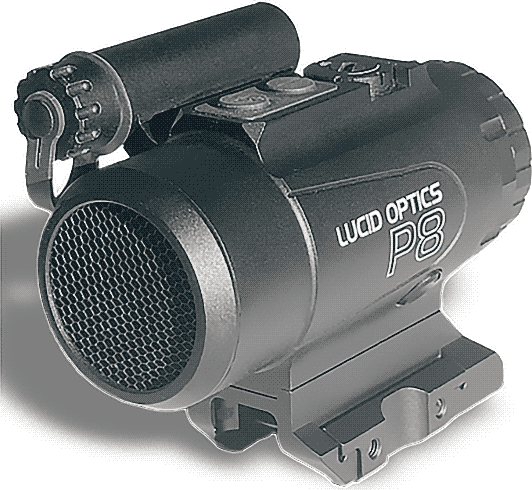
Lucid Optics P8 Prism Optic.
The report covers:
- What is a prismatic optic?
- The proof
- Astigmatism
- Cost
- Illuminated reticle
- Reticle size
- Scope ?
- Fixed power
- Mounting the P8
- Mounts
- It fits!
- Summary
Today we start looking at the Lucid Optics P8 Prism Optic. Like me, you may want to know what a prismatic optic is. So let me give you two definitions.
What is a prismatic optic?
From the Pew Pew Tactical page on prismatic optics – “Long story short…they are fixed magnification optics that use a prism (whoa) instead of the two objective and ocular lenses of a traditional scope.”
I’m not sure what “(woah)” means in this definition, other than the writer is excited. I read the rest of his report and here is what I got. A prismatic optic is better for those with astigmatism than a dot sight. The writer called them red dot sights but since they come in a range of colors I’ll just call it a dot sight.
Maybe (woah) is a word that has descriptive meaning in optics — I don’t know. What I do know is, that definition didn’t tell me what a prismatic sight is.
So I went to the Recoil website and got this.
A product of the ’80s, the prism scope would fully blossom during the Global War on Terror. Initially designed as a way to fit the magnification of a traditional riflescope into a lighter, compact package, the designer of the original ACOG, Glyn Bindon, took inspiration from a pair of binoculars. Where the length of a traditional telescopic riflescope required the length of the tube to function, a prism scope could shorten the overall length by reflecting the image inside the body of the sight. With lenses at each end, and a prism in the middle to achieve the required distance between them via reflection, the optic style earned its name.
Well, BB knows what binoculars are and he knows that prismatic binocs are shorter than non-prismatic binocs of the same power. The prism is used to redirect the path of light inside the binocs so a longer light path can fit into a shorter package, exactly as described in the second description. Shorter is a good thing for optics on firearms.
Therefore BB assumes that a prismatic optic is shorter than a non-prismatic one, and that is what all the websites say.
The proof
Cooks say that the proof is in the pudding, which means taste the food and you will know if it’s good. That definition expands to most things — try them and you will see if they are good. So, I told you that I was at AirForce Airguns on Friday, two weeks ago and I picked up Ton Jones’ RAW MicroHunter to see how it felt when shouldered. To the detriment of my corporate wallet, he has a Lucid P8 sight mounted and the reticle was turned on. After looking through that sight I set the rifle down and immediately called Lucid Optics to purchase a P8 for myself. That would be the proof of the pudding, in this case.
Guys, I have praised Meopta scopes to the heavens and those who have bought them now do the same. I have praised Integrix scopes and we will soon be hearing from those who purchase them. Today I’m praising the Lucid Optics P8.
Astigmatism
How does the eye condition known as astigmatism affect shooters who use dot sights? Well, I have astigmatism and seeing the following images from the AT3 Tactical website explained a lot.
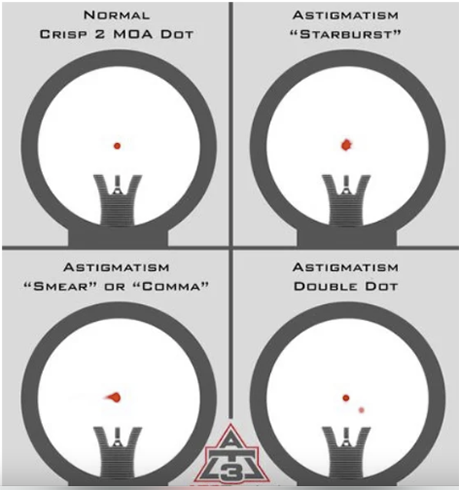
This is what a dot looks like if you have astigmatism.
I see the “Starburst” image in dot sights. But when I first looked through the P8 sight everything was sharp. It was like putting on hearing aids for the first time — Wow! Is that the way things sound? Only in this case it was — Wow! Is that the way things look? That is why I bought this sight so quickly. I don’t buy sights to save money. I buy them to see what I’m shooting at.
Thanks to reader thedavemeister, we can see what it looks like to look through the P8 at a target 50 yards awa.
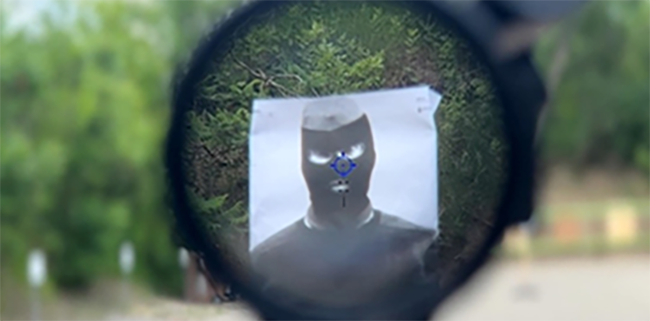
What the actual P8 reticle looks like.
Cost
According to Pew Pew Tactical you need to pay as much as $300 to get a good prismatic optic. Well, the P8 I now own and am testing costs twice that. Since I have never seen another prismatic rifle sight, I have no basis for comparison. I just know that once I looked through this one I bought it. I did the same thing with hearing aids, so take that with a grain of salt. I tend to buy stuff that works, if I can afford it.
Illuminated reticle
The reticle is illuminated with a blue light and it’s an etched glass reticle. That means that only the reticle lights up — there is no blooming of light inside the scope. There are two buttons on top of the scope that adjust the level of illumination.
Thank you, Lucid Optics, for using a blue light. I am red/green colorblind like 14 percent of all males and blue is quite visible to my eyes.
The battery that powers the reticle is a triple A and Lucid recommends using a lithium battery. They say to expect up to 25,000 hours of battery life. The illumination shuts off automatically after 2 hours.
Reticle size
The illuminated portion of the reticle has specific elements that can be used for a variety of purposes like range estimation and holdover. The bottom portion of the reticle does not illuminate. It is not necessary to illuminate the reticle to see it or to use the sight. In that respect it’s more like a scope than a dot sight.
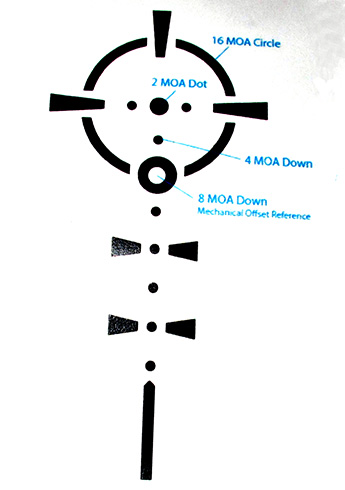
The P8 reticle is illuminated on top but it can be seen all the time without illumination.
Scope ?
I’m calling this a scope because it magnifies the target four times. But it also acts like a dot sight. I guess it is the best of both worlds. But it also means that this optic has an eye relief distance like a scope. In this case it’s 3 inches. A dot sight would have no eye relief, so when you mount the P8 that must be taken into consideration.
The exit pupil is 6mm, which in a scope is like looking through a large sewer pipe. It’s easy to see through the P8 and hard not to get it right.
Also the reticle remains crystal clear even when your eye isn’t at the right distance from the lens. The image gets smaller with a dark ring around it like it does on a quality scope, but you can still see the reticle and your target.
Fixed power
We have been discussing the benefits of fixed power scopes for several weeks. All prismatic optics are fixed power. The P8 is 4 power. Five power appears to be the maximum that’s possible with a prismatic. So this is a scope for hunting. Now, let’s see — do I have an airgun that’s made for hunting? Hmmm. Oh, right! I have the RAW MicroHunter. And, coincidentally that was the rifle I first saw this scope mounted on.
Mounting the P8
The MicroHunter comes with an 11mm dovetail scope base, so a UTG adaptor needs to be used.
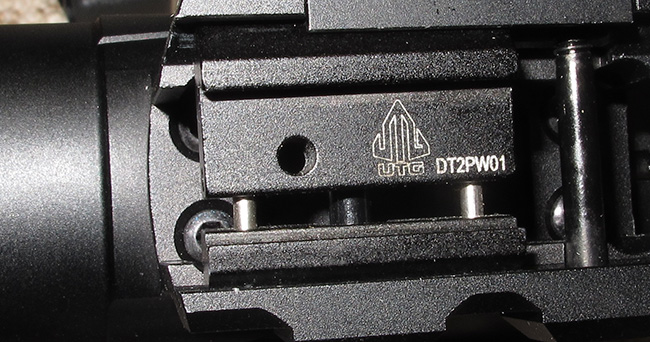
The UTG Picatinny-to-11mm-adaptor makes the P8 work fine. There is only room for one of these but since I’m mounting to a PCP, no sweat!
The P8 comes with three different height mount risers. They are made to interface with Picatinny bases because this sight is made primarily for firearms. The highest mount riser is perfect for the MicroHunter. I’ll save the other two for when I mount the sight on different airguns.
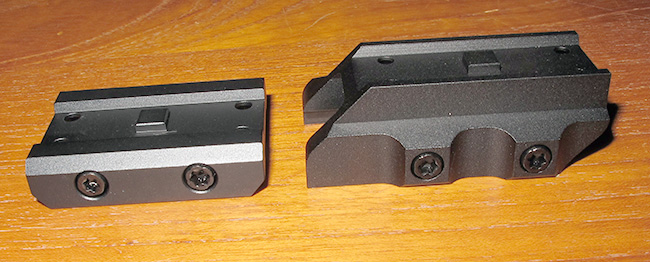
The P8 comes with three mount risers. The highest was used, leaving the other two for future airguns.
Mounts
Lucid Optics recommends tightening the screws on the base of the mount to no more than 22 inch-pounds. Once again we have an inch-pound torque spec! Do I really need to get one? Even if I do, I ain’t a-gonna for awhile. With the HW 50 I calibrated my finger to inch-pounds while fixing that stripped screw on the Rekord trigger. That calibration should last for the next year or so.
One strange thing was the two mount clamp screws were different sizes! One has a T15 head and the other a T10 head! I’ve never seen that before. Someone in assembly probably reached into the wrong box.
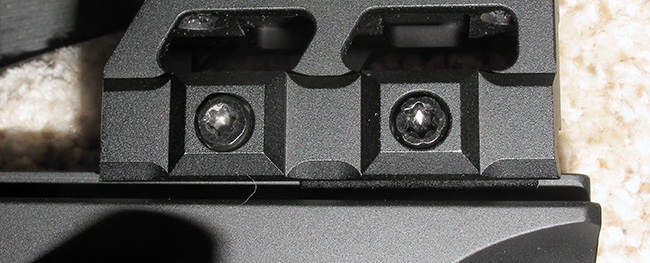
The P8 clamp screws on my sight have two different size heads! T10 on the left and T15 on the right.
It fits!
The P8 fits the MicroHunter like it was made for it. I thought my eye would be too close to the eyepiece of the scope, but just cranking the MicroHunter buttplate out 3/4-inches made the eye relief perfect. It is as if someone actually thought the rifle through.
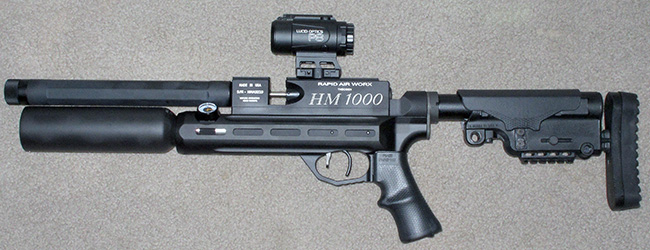
The Lucid P8 looks right on the AirForce MicroHunter. It may look high here but my sighting eye is in perfect alignment with the P8 eyepiece.
And guess what? The MicroHunter fits into its carrying case with the P8 mounted!
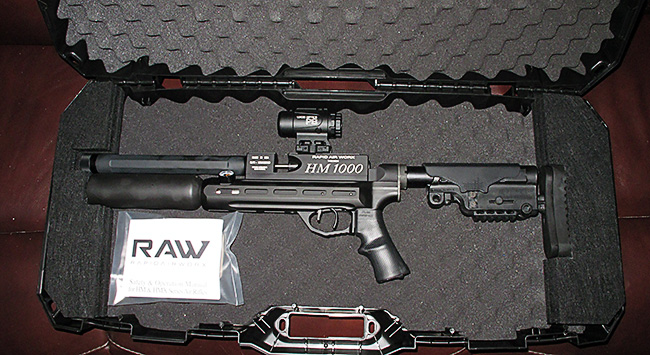
The P8 mounted on the Microhunter fits in the case like it was made for it. It wasn’t, but the fit is perfect.
Summary
We have another optic to consider. This one is for shorter distances, but also perfect for hunting. Or is it? We shall see.

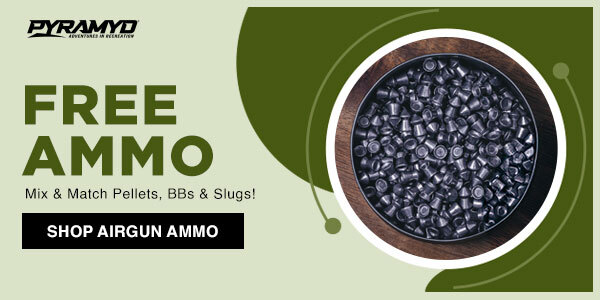
B.B.
Aren’t some binoculars prismatic?
-Y
Yogi,
Almost all binoculars are prismatic these days. About a century ago they were mostly Porro Prisms. Roof Prisms are now used for compactness.
For ultimate light gathering Abbe-Koenig prisms are used
https://en.m.wikipedia.org/wiki/Abbe%E2%80%93Koenig_prism
shootski
BB,
I take it that pic under “Reticle Size” is just artwork to show what it looks like looking through the Prizm.
If that’s the case, if possible, I’d love to see a pic of how the sight actually looks looking through it. 🙂
Thank you!
Take care & God Bless,
dave
dave,
I’ll look into it.
BB
Thanks, BB; I sent you a personal email on this; I hope it makes it through to you. 😉
dave,
Got it and working on it. Thanks,
BB
Cool; thank you. 🙂
Tom,
When you said the exit pupil was 6mm does that mean this scope has 24mm lenses? Traditionally exit pupil is computed by dividing the objective lens size by the magnification. The tube of the P8 looks bigger than an inch in diameter.
Siraniko
TOM: You’ve been hailing the wonders of the UTG Bug Buster Scopes for a number of years now. How would one of these P-8 Optics compare with a Bug Buster scope? I probably don’t understand the technologies involved here, but at some point I’ll want to “scope” my Dragonfly. What should I use? I don’t have any significant astigmatism, but a normal 30mm scope is usually too long for my gun. A UTG Bugbuster is what I’ve been aiming for, but now this P-8 prismatic optic steps forward. BB, put me in my place or tell us a comparison is on the burners. . . Thanks, Orv.
Orv,
Tough call. I’d stay with the Bug Buster.
BB
Orv,
Maybe in the future, someone will figure out an etched glass reticle would be a good thing to put in a BugBuster.
RR
It is soon to be released. It was at the 2023 SHOT show.
SL,
Yes, and I showed it in my report.
BB
Doc
For what it’s worth, I scoped my Dragonfly with the same bug buster BB used on his and it is a good fit.
The thing a person has to keep in mind is that there is not much real estate on these smaller scopes so not too much variability as to where you can place your rings.This can cause issues with eye relief.
That being said I own a number of bug busters and I think they are fantastic scopes for the money.
I’m already a fan of Leaper’s scopes, so it’s not much of a step into the UTG Bugbusters. I’ll likely order one this Fall to put on my Dragonfly. A man, at least this one, can’t have too many toys. Tom, at least you get paid to play with your toys. Such a deal! Orv.
Siraniko,
No, the scope’s lenses are larger than 30mm.
BB
Siraniko: I now realize that I wasn’t clear. I was referring to the scopes tube of 30 ml diameter verses to 1″ tube diameter. Orv.
I’ve read of this type of scope used on small carbines with good results.
And weren’t there some prismatic scopes made pre-WW1? I am thinking one of the early Casey and Warner scopes the Army trialed was a prismatic.
Buckeye,
I don’t know.
BB
The M1908 Warner & Swasey Musket Sight must be one of the first.
Thanks, I was going by memory. Remembered there was an early sniper scope that was described as prismatic, but only sort of remembered the manufacturer name.
BB there are a lot of low to reasonable priced optics available for Airsoft. I get a lot of them simply to replace open sights. I imagine a lot of them would be destroyed on a magnum or high-powered airgun, but they seem to work fine for gas powered airguns. I’m sure the glass is not great, and you would probably be shortchanging yourself by using some on a high-end pellet rifle but for close up shooting on low end airguns, mainly used for plinking, the price is right.
Do you have any idea where they cut corners the most on them to keep the price low or is it just everything involved?
Is that flash screen removable? Looks like it would block quite a bit of light.
Tossup between the AAA and the small pill batteries. Easy to get and bigger or lighter weight and smaller?
Bob M-
The flash screen or ARD is useful when hunting or on the two-way range. I wouldn’t bother removing it because the cell wall thickness is minuscule and doesn’t affect light transmission.
pacoinohio,
The other reason I asked has to do with how exposed it is to possible damage and being able to replace it or not.
Bob M-
They are usually behind the flip up scope covers for protection. I’ve used them for 20-25 years. Sometimes the honeycomb gets dinged. Really doesn’t affect the sight picture, but I will use a pick or bullet point to straighten. Overall, I’d say they hold up well. Check out Tenebraex KillFlash by Armament Technology for more background information.
Hmmmmmm… Tomek does not see any big advantage so far. I can understand the feeling to put something strange on the gun may be enough 🙂 but could somebody please reveal some advantage of this solution?
tomek,
You have to see it to understand. And maybe it isn’t for everyone.
BB
tomek,
The main advantage to the prismatic scopes is they are shorter. As OP has pointed out they have been around for sometime, but it was not until “recent” years that the cost had come down enough to make such practical.
Like precision ground lenses, precision ground prisms can be expensive.
Newtoynewtoynewtoy!
The difference between man and boys is the price of their toys 🙂
OK I understand the size does matter.
If B.B. tells me I need to see it to understand I can directly follow this path 🙂 Similar with CO2 pistols – suddenly I’m on it, never thought I will ever buy CO2 revolver or the BB Makarov…
LOL! I have been down both roads! I have even made a slight turn into CO2 and found it is not for me, although if I was to get my paws on a Giffard I would try it out again. 😉
Ridge – I still think CO2 is not for me but somehow I have to try it on my own. So far I discovered how much fun fast revolver shooting might be 🙂 It is one more thing in my life which force me to never say never 🙂
Seems that one advantage over a non-prismatic dot sight is the improved clarity of the dot for those with astigmatism. I tend to see a “comma” similar to the AT3 Tactical website image BB used in the blog.
BB,
For a sproinger, you could use one of those long 11mm to Picatinny adapters and one of the short bases on this prismatic scope.
I am interested in “seeing” the actual reticle as is Dave. I have seen some superb etched reticles over the years, but personally do not have much use for those reticles with the Christmas trees on the lower part. I have recently been seeing some without all of that stuff on the top. I do not do much hold under myself and less clutter in the optics is better IMMHO. 😉
RR,
Like you I prefer simple reticles, I have one scope (Hawke Sidewinder) with the “Christmas tree” and find it to be too busy. Hard to beat the old duplex reticles for fast target acquisition in heavy bush.
Another trend to day seems to be super fine reticles. Guess that they are ok for extreme range target work but I find that they are difficult to see when hunting in low light levels.
FFP vs SFP is also a thing. Bought a Element Titan FFP and the cross hairs are almost invisible at low power and still very fine at high. It’s tolerable being mounted on my bench rifle (Panthera) but I’d never considered one for the type of hunting I do. I’ll stick with SFP.
Find myself thinking about getting smaller/lighter fixed power scopes for some of my rifles.
Hank
I personally like the BugBusters, but would prefer a little slimmer reticle than they provide. I have a Hawke 2-7X32 with a glass etched mild-dot reticle that I consider the cat’s meow. It is heavier than most glass etched reticles and the low power is nice in the woods. I think this is where Leapers needs to go. They also should have kept their 4X and 6X scopes also.
Since I almost never adjust powers, unless the FFPs become cheaper than the SFPs, I will stick with those also.
BB
“Five power appears to be the maximum that’s possible with a prismatic.”
As far as I can tell the maximum magnification seems to be x12, an example being the MTC Swat prismatic 12×50
Ade,
Thanks for that. I was going by one of the other reports — probably an older one.
BB
Tom,
What’s the parallax situation with this optic?
BB,
Thanks for this! Seen these prism optics in videos a couple of times and wondered about them.
I’m still at the “they look odd” stage of assessment so I’m approaching prism optics the way two dogs, meeting for the first time, circle while considering a potential threat. Understand that I’m just starting to get comfortable with dot sights; as a traditional dinosaur, this could take a while. 😉
I like plinking and I shoot fast, the prism sight might suit my style well. Looking forward to more on the Lucid.
Hank
Hi everybody,
I wonder if the “astigmatism” graphic should be taken with a grain of salt.
I have a Simmons and a Diana red dot sight. I think they cost € 35 and € 60 respectively.
The further I crank up the brightness, the more I can see mild “starburst” or “smear” effects. But I think it’s quite likely that this is caused by the pretty affordable sights, not necessarily by astigmatism.
Apart from that, they work just fine for 10 meter indoor shooting. They have 11 levels of brightness and work best at 2 or 3 for my needs.
Stephan
After some thought, I decided that I would only spend lots of money on optics if it was a necessary part of my job or a big improvement, like BB, I was into professional target shooting or big game hunting. Serious stuff and perhaps a self-defense weapon.
Pest control, plinking and casual target shooting, or practice, simply does not require it, in my opinion.
Another exception would be to put it on a $2,000. or totally accurate airgun to get the most out of it for distance shooting as required.
Wait a sec … I own one or two of those. Like the Sidewinder PCP. But then again, I can’t see pests that far away. 🙁
Another great series B.B. – I love to learn about new technology and although the prismatic optics are not exactly ‘new’ they have become mainstream very recently.
Now, do I ‘need’ one? Hmmm. I will wait to the following blogs on this series to find out.
Best,
Henry
B.B.and Readership,
Sounds like many of you have a steep learning curve to climb about Prismatic Dot sights.
A few sources: https://www.optics-trade.eu/blog/category/dot-sights/dot-sights-news/
https://www.recoilweb.com/prism-scope-overview-170453.html
I have been using them for years in aircraft, on firearms, as well as airguns. In aircraft they are called Heads-up displays and are begining to show up in Automobiles.
They can be 1X or nX.
This is my first that i bought rather than had issued by the Government: https://vortexoptics.com/vortex-spitfire-3x-ebr556b-moa-prism-scope.html
One sits on my AR and one is on my .58 DAQ Shortrifle or switched easily to my .58 DAQ Pistol/STOCKED pistol; some of you would call a carbine.
You still have to deal with eye relief. If you need a longer than 3” eye relief it might be problematic for you to use one; especially with higher magnification.
Prism scopes can have parallax, just like an LPVO (Low Power Variable Optic.) The amount is usually pretty negligible for most shooters. Plus, as we have learned, keeping a good cheek weld and a good, consistent position can easily solve this problem.
These prism sights work well at short and medium firearm ranges and will meet most airgun needs as long as you buy the right one for you. A 1X with a separate magnifier will increase the range of usability as long as you have the Optics Real Estate available on your airgun.
Shootski
So no good for pistol shooters?
-Yogi
Yogi,
No pistol prismatic scopes to the best of my knowledge. Just not enough movement in the prisms to allow for that is what i suspect is the problem.
shootski
It sounds like BB sprained his wrist in a rush to get his wallet out of his pocket.
Maybe this type sight would work well for FM’s tired eyes, but would want to at least have a look thru one first. Have a feeling a Bug Buster would do the job for less. We shall see. 🙂 Pun intended.
The difference between a traditional riflescope and a prismatic sight is difficult to explain to the layman.
One could build a prismatic sight that would feel just like a regular rifle scope. However, modern prismatic sights have very large eye boxes, which allows the shooter to use the scope similar to a red dot sight, in that he sees no vignetting etc.
I’m getting a masters class on optics today. . . and I’m actually staying awake in class. Wow! I think that for now I’ll just watch these prismatic optics. At some point I’ll probably put a Bug Buster on my Dragonfly, but for now, my grandson and I can hit whatever we’re aiming for just using the iron sights. The time is coming when he’ll want more and I’ll need more to focus on our chosen targets. Then, it’s UTG time! Orv.
“Thanks to reader thedavemeister, we can see what it looks like to look through the P8 at a target 50 yards away.”
Great pic, BB! LOL 😉
Noticed the term DOT sight can be a bit misleading. It describes what you see but not the description of the optic involved.
Is it a flat screen reflex or tubular reflex or what have you.
When I want to use a both eyes open dot sight, I want as clear a picture of the target and surrounding area as I can get, usually to track movement. No knobs or thick housings and pop open lens covers obstructing my view. A simple stand alone reflex screen with a thin housing.
Some are delicate looking but offer the best view and some have a substantial thin tube, or rectangular, type housing for better protection.
I consider the larger ones Advanced Combat Optical Gunsights, ACOG. Rugged housings, protected lens covers with additional options and easy to access adjustment knobs.
Everything in between is a compromise for the shooters desire but seem to be lumped into the DOT sight category because they are short.
Bob M,
Dot Sight
It sure can be confusing.
The Prism or prismatic optics usually have a reticle most often etched on glass or an optical plastic and always use prism(s) to invert and usually to mirror the image. The reticle may be a simple dot, circle(s), cross hairs, duplex, BDC, and any other type also used in telescopic sights.
They are much different than a single lens REFLEX sight that uses a light source projected on a lens to form the DOT/Aim Point. AND, they work when the battery/accumulator dies as a black unilluminated reticle.
shootski
B.B.,
https://www.scheels.com/p/vortex-torque-wrench/84382910562.html
You know you ought to have at least one!
shootski